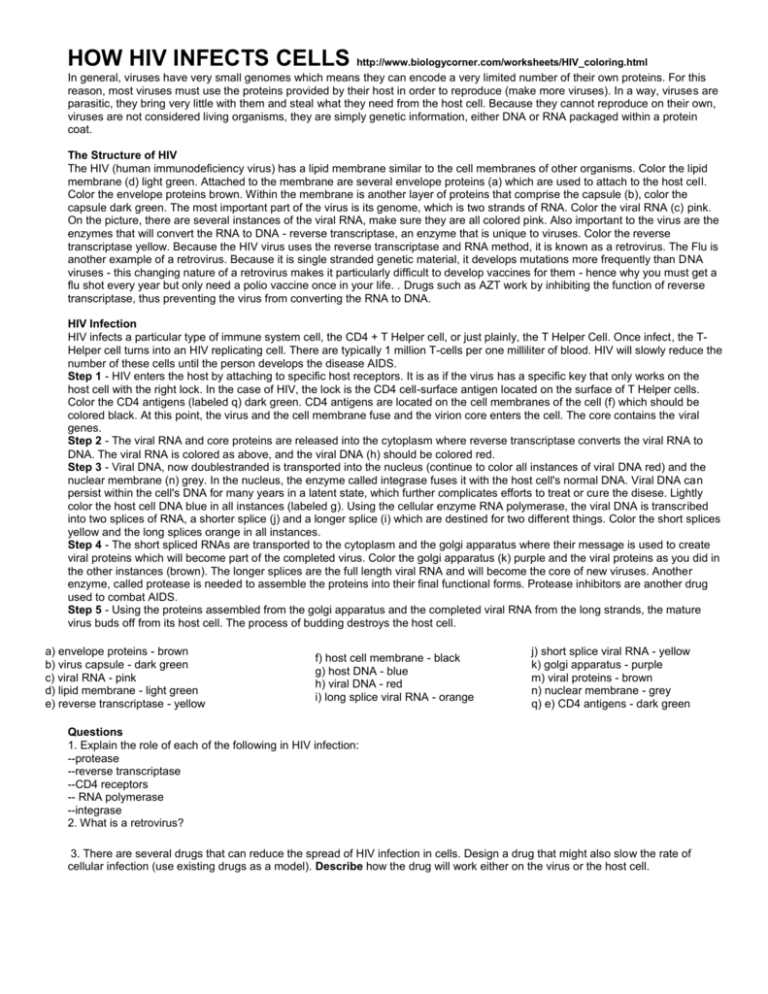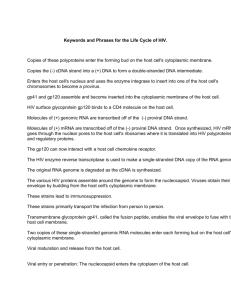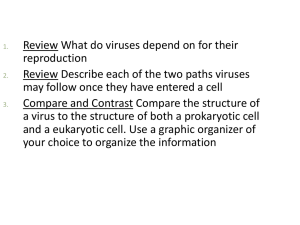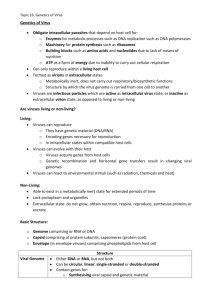how hiv infects cells
advertisement

HOW HIV INFECTS CELLS http://www.biologycorner.com/worksheets/HIV_coloring.html In general, viruses have very small genomes which means they can encode a very limited number of their own proteins. For this reason, most viruses must use the proteins provided by their host in order to reproduce (make more viruses). In a way, viruses are parasitic, they bring very little with them and steal what they need from the host cell. Because they cannot reproduce on their own, viruses are not considered living organisms, they are simply genetic information, either DNA or RNA packaged within a protein coat. The Structure of HIV The HIV (human immunodeficiency virus) has a lipid membrane similar to the cell membranes of other organisms. Color the lipid membrane (d) light green. Attached to the membrane are several envelope proteins (a) which are used to attach to the host cell. Color the envelope proteins brown. Within the membrane is another layer of proteins that comprise the capsule (b), color the capsule dark green. The most important part of the virus is its genome, which is two strands of RNA. Color the viral RNA (c) pink. On the picture, there are several instances of the viral RNA, make sure they are all colored pink. Also important to the virus are the enzymes that will convert the RNA to DNA - reverse transcriptase, an enzyme that is unique to viruses. Color the reverse transcriptase yellow. Because the HIV virus uses the reverse transcriptase and RNA method, it is known as a retrovirus. The Flu is another example of a retrovirus. Because it is single stranded genetic material, it develops mutations more frequently than DNA viruses - this changing nature of a retrovirus makes it particularly difficult to develop vaccines for them - hence why you must get a flu shot every year but only need a polio vaccine once in your life. . Drugs such as AZT work by inhibiting the function of reverse transcriptase, thus preventing the virus from converting the RNA to DNA. HIV Infection HIV infects a particular type of immune system cell, the CD4 + T Helper cell, or just plainly, the T Helper Cell. Once infect, the THelper cell turns into an HIV replicating cell. There are typically 1 million T-cells per one milliliter of blood. HIV will slowly reduce the number of these cells until the person develops the disease AIDS. Step 1 - HIV enters the host by attaching to specific host receptors. It is as if the virus has a specific key that only works on the host cell with the right lock. In the case of HIV, the lock is the CD4 cell-surface antigen located on the surface of T Helper cells. Color the CD4 antigens (labeled q) dark green. CD4 antigens are located on the cell membranes of the cell (f) which should be colored black. At this point, the virus and the cell membrane fuse and the virion core enters the cell. The core contains the viral genes. Step 2 - The viral RNA and core proteins are released into the cytoplasm where reverse transcriptase converts the viral RNA to DNA. The viral RNA is colored as above, and the viral DNA (h) should be colored red. Step 3 - Viral DNA, now doublestranded is transported into the nucleus (continue to color all instances of viral DNA red) and the nuclear membrane (n) grey. In the nucleus, the enzyme called integrase fuses it with the host cell's normal DNA. Viral DNA can persist within the cell's DNA for many years in a latent state, which further complicates efforts to treat or cure the disese. Lightly color the host cell DNA blue in all instances (labeled g). Using the cellular enzyme RNA polymerase, the viral DNA is transcribed into two splices of RNA, a shorter splice (j) and a longer splice (i) which are destined for two different things. Color the short splices yellow and the long splices orange in all instances. Step 4 - The short spliced RNAs are transported to the cytoplasm and the golgi apparatus where their message is used to create viral proteins which will become part of the completed virus. Color the golgi apparatus (k) purple and the viral proteins as you did in the other instances (brown). The longer splices are the full length viral RNA and will become the core of new viruses. Another enzyme, called protease is needed to assemble the proteins into their final functional forms. Protease inhibitors are another drug used to combat AIDS. Step 5 - Using the proteins assembled from the golgi apparatus and the completed viral RNA from the long strands, the mature virus buds off from its host cell. The process of budding destroys the host cell. a) envelope proteins - brown b) virus capsule - dark green c) viral RNA - pink d) lipid membrane - light green e) reverse transcriptase - yellow f) host cell membrane - black g) host DNA - blue h) viral DNA - red i) long splice viral RNA - orange j) short splice viral RNA - yellow k) golgi apparatus - purple m) viral proteins - brown n) nuclear membrane - grey q) e) CD4 antigens - dark green Questions 1. Explain the role of each of the following in HIV infection: --protease --reverse transcriptase --CD4 receptors -- RNA polymerase --integrase 2. What is a retrovirus? 3. There are several drugs that can reduce the spread of HIV infection in cells. Design a drug that might also slow the rate of cellular infection (use existing drugs as a model). Describe how the drug will work either on the virus or the host cell.







